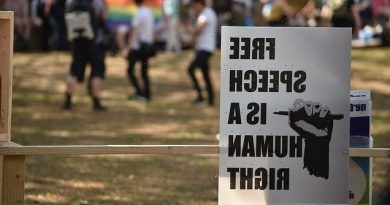Cyclone bomb path tracker 2021 LIVE – Seattle to be hit by BRUTAL subzero weather storm that will 'rival a hurricane'
SEATTLE is set to be hit by a cyclone that will rival the intensity of strong hurricanes and will bring dangerous and damaging impacts up and down the West Coast.
The moisture associated with the storm will come all the way from India and other parts of the southeast Asia according to Senior Meteorologist and Manager of Forecasting Technology Mike Doll.
Snow is expected to fall at various elevations over the course of several days.
Further south 8 feet of snow is predicted over the highest ridges and peaks in the central and northern Sierra Nevada.
Read our Cyclone Bomb live blog below for the latest updates…
- Danielle Cinone
NOT ALL BOMB CYCLONES ARE HURRICANES
“All bomb cyclones are not hurricanes,” University of California, Los Angeles, climate scientist Daniel Swain told NBC News back in 2019.
“But sometimes, they can take on characteristics that make them look an awful lot like hurricanes, with very strong winds, heavy precipitation and well-defined eye-like features in the middle.”
- Danielle Cinone
SEE THE BOMB CYCLONE FORM
Meteorologist Scott Sistek also shared this image of the bomb cyclone forming over the ocean.
- Danielle Cinone
WHAT IS A HURRICANE?
Powerful storms arising in the Atlantic or eastern Pacific are called hurricanes.
North of the equator they spin anticlockwise because of the rotation of the earth.
They turn the opposite way in the southern hemisphere.
Cyclones are like giant weather engines fuelled by water vapour as it evaporates from the sea.
Warm, moist air rises from the surface, creating a low pressure system that sucks in air from surrounding areas – which in turn is warmed by the ocean.
As the vapour rises it cools and condenses into swirling bands of cumulonimbus storm clouds.
- Danielle Cinone
STORM MAY ‘SHUT DOWN’ WILDFIRE SEASON
The storm could potentially “knock temperatures down and may also effectively shut down the wildfire season in much of California,” AccuWeather Meteorologist Alex DaSilva noted.
Other storms earlier this fall and late in the summer did the same in the coastal Northwest, DaSilva said.
- Danielle Cinone
‘IT WILL EXPLODE OUT OF NOWHERE’
“What is remarkable is how big it is in scale, how deep the center is and the speed with which it goes from an open wave to a super-intense low-pressure system,” Joe Boomgard-Zagrodnik, an agricultural meteorologist for Washington State University, told The Seattle Times.
“Meaning it will seem to explode out of nowhere.”
- Danielle Cinone
'MINIMAL IMPACT' ON SEATTLE WEATHER
The "bomb cyclone" will likely have minimal impact on weather in the Seattle area and bring strong hurricane winds to the northeast Pacific Ocean, KOMO News reported.
KOMO News meteorologist Kristin Clark said: "We are tracking the strongest storm in the northeast Pacific since April 2012, but it is a near miss for Western Washington.
"The storm stays clear offshore and heads due north into British Columbia Canada."
- Danielle Cinone
‘MAY BE ONE OF THE BIGGEST SERIES OF STORMS’
“The pattern unfolding this week to next week may be one of the biggest series of storms for the rainy season for California, but there is still potential for a couple of bigger storms over the winter,” said AccuWeather forecaster Paul Pastelok, according to USA Today.
- Danielle Cinone
'THERE WILL BE SNOW'
"And there will be snow," AccuWeather warned on Twitter.
"Up to 2 feet could fall over the highest elevations of the Sierra Nevada Mountains Sunday into Monday alone, and snow totals through next Wednesday could top 6 feet in some high elevation places."
- Danielle Cinone
OTHER MAJOR TROPICAL STORMS OF THE LAST 20 YEARS
Some of the major storms and hurricanes since 2000 include:
- Tropical Storm Allison (2001)
- Hurricane Isabel (2003)
- Hurricane Charlie (2004)
- Hurricane Jeanne (2004)
- Hurricane Dennis (2005)
- Hurricane Katrina (2005)
- Hurricane Rita (2005)
- Hurricane Ike (2008)
- Hurricane Sandy (2012)
- Hurricane Maria (2017)
- Hurricane Dorian (2019)
- Hurricane Zeta (2020)
- Tropical Storm Eta (2020)
- Tropical storms Amanda and Cristobal (2020)
- Tropical Storm Claudette (2021)
- Tropical Storm Henri (2021)
- Danielle Cinone
‘RAPIDLY STRENGTHENING STORM’
Meteorologists say a bomb cyclone is “a rapidly strengthening storm with a central pressure that plummets by 0.71 of an inch of mercury (24 millibars) or more within 24 hours,” Accuweather reported.
That is also referred to as bombogenesis.
“As the pressure drops rapidly in the center of the storm, air rushes in to replace the vacuum created in the atmosphere and can produce damaging winds,” the site revealed.
- Danielle Cinone
WHEN DOES A DEPRESSION BECOME A TROPICAL STORM?
When the wind speed increases to reach between 39 and 73m mph, the tropical depression becomes a tropical storm.
Typically, the winds blow faster and start to resemble a hurricane with a circular shape.
- Danielle Cinone
WHAT KIND OF DAMAGE DOES A TROPICAL STORM BRING?
Most damage from tropical storms comes from heavy rainfall which can destroy buildings and cause severe flooding.
Landslides can also occur, blocking roads and railways and causing evacuation problems for the emergency services.
In the most extreme cases, this can lead to a shortage of food and clean water.
Henri, which was downgraded from a hurricane, brought several inches of rainfall in the Northeast, along with up to 70 mph wind gusts.
- Danielle Cinone
WHAT IS A BOMB CYCLONE?
Bombogenesis is a storm that undergoes rapid strengthening with the majority of most storms occurring over the ocean.
The storm can be tropical or non-tropical in nature.
This can be known as either weather bomb, or simply bomb cyclone.
- Danielle Cinone
WHAT IS A TROPICAL DEPRESSION?
A tropical depression is categorised as one of the four stages of a tropical cyclone.
It forms when a thunderstorm grows higher and larger causing the air at the top to become unstable.
As the heat energy is released from the cooling water vapor, the air at the top of the clouds becomes warmer, making the air pressure higher and causing winds to move outward away from the high pressure area.
Winds in the storm cloud then created start to spin faster and faster, whipping around in a circular motion.
When the winds reach between 25 and 38 mph, the storm is considered a tropical depression.
- Danielle Cinone
NAME CRITICIZED BY SOME WEATHER EXPERTS
The term “bomb cyclone” was established in 1980 and has been criticized by some meteorologists for being “sensationalist,” The Independent reported.
“Bombogenesis is the technical term. ‘Bomb cyclone’ is a shortened version of it, better for social media,” weather expert Ryan Maue told the outlet.
“The actual impacts aren’t going to be a bomb at all. There’s nothing exploding or detonating.”
- Danielle Cinone
STRONG WINDS EXPECTED
Possible 60 to 70 mile per hour winds are forecast for the West Coast, according to KXLY.
“These wind speeds are similar to a strong tropical storm, a few miles-per-hour below hurricane force,” the outlet noted.
- Danielle Cinone
SEE THE BOMB CYCLONE FORM
Meteorologist Scott Sistek also shared this image of the bomb cyclone forming over the ocean.
- Danielle Cinone
'MINIMAL IMPACT' ON SEATTLE WEATHER
The "bomb cyclone" will likely have minimal impact on weather in the Seattle area and bring strong hurricane winds to the northeast Pacific Ocean, KOMO News reported.
KOMO News meteorologist Kristin Clark said: "We are tracking the strongest storm in the northeast Pacific since April 2012, but it is a near miss for Western Washington.
"The storm stays clear offshore and heads due north into British Columbia Canada."
- Danielle Cinone
'MAY BE ONE OF THE BIGGEST SERIES OF STORMS'
"The pattern unfolding this week to next week may be one of the biggest series of storms for the rainy season for California, but there is still potential for a couple of bigger storms over the winter," said AccuWeather forecaster Paul Pastelok, according to USA Today.
- Danielle Cinone
'RAPIDLY INTENSIFYING'
"This storm has been rapidly intensifying over the past 24 hours," WVLT reports.
- Danielle Cinone
'BOMB CYCLONE' OFF WASHINGTON STATE COAST
WVLT Meteorologist Ben Cathey shared radar footage on Twitter of the "bomb cyclone" off the coast of Washington State and Vancouver Island.
He labeled the storm as "beast" after saying it "dropped well over 24 mb in 24 hours."
Cathey warned of big waves, lots of snow, and high winds.
- Danielle Cinone
NOT ALL BOMB CYCLONES ARE HURRICANES
“All bomb cyclones are not hurricanes,” University of California, Los Angeles, climate scientist Daniel Swain told NBC News back in 2019.
“But sometimes, they can take on characteristics that make them look an awful lot like hurricanes, with very strong winds, heavy precipitation and well-defined eye-like features in the middle.”
- Danielle Cinone
'THERE WILL BE SNOW'
"And there will be snow," AccuWeather warned on Twitter.
"Up to 2 feet could fall over the highest elevations of the Sierra Nevada Mountains Sunday into Monday alone, and snow totals through next Wednesday could top 6 feet in some high elevation places."
- Danielle Cinone
OTHER MAJOR TROPICAL STORMS OF THE LAST 20 YEARS
Some of the major storms and hurricanes since 2000 include:
- Tropical Storm Allison (2001)
- Hurricane Isabel (2003)
- Hurricane Charlie (2004)
- Hurricane Jeanne (2004)
- Hurricane Dennis (2005)
- Hurricane Katrina (2005)
- Hurricane Rita (2005)
- Hurricane Ike (2008)
- Hurricane Sandy (2012)
- Hurricane Maria (2017)
- Hurricane Dorian (2019)
- Hurricane Zeta (2020)
- Tropical Storm Eta (2020)
- Tropical storms Amanda and Cristobal (2020)
- Tropical Storm Claudette (2021)
- Tropical Storm Henri (2021)
WIND WARNINGS IN PLACE
Wind warnings are in place for the coast in Canada from this storm, KXLY reported.
However, the Washington and Oregon coasts should see much milder winds more in the 30 to 40 mile per hour range.
“The windy core of the storm will keep heading north towards Alaska before fizzling out,” the outlet revealed.
Source: Read Full Article


